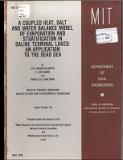A Coupled Heat, Salt and Water Balance Model of Evaporation and Stratification in Saline Terminal Lakes: An Application to the Dead Sea
Author(s)
Salhotra, Atul Mohan; Adams, E. Eric; Harleman, Donald R. F.
Download16670980.pdf (11.73Mb)
Metadata
Show full item recordAbstract
A time varying, one-dimensional, coupled heat, salt and water budget model is developed for a hypersaline water body in which the vertical stability depends on the opposing influences of temperature and salinity stratification. A mixed layer modelling approach is used in which entrainment from the hypolimnion into the epilimnion occurs as a result of mass, heat, salt and momentum fluxes at the water surface. The effect of salinity on evaporation has been discussed in detail using evaporation pan data collected at the Dead Sea. An accurate method to account for this effect based on the dependence of saturation vapor pressure on salinity and ionic composition is suggested and shown to be superior to the commonly used approach based on the ratio of salt water to fresh water evaporation. Also, the negative feedback effect of temperature on salinity has been quantified. A comparison of various formulae to compute atmospheric long wave radiation is presented. Using data collected at the Dead Sea these formulae have been calibrated to account for site specific conditions. The importance of using accurate cloud cover values is indicated. The primary components of the mixing algorithm are wind stirring and penetrative convection. The relative magnitudes of each during different periods in a year are compared. On an annual level, the energy supplied by wind mixing is significantly larger than the penetrative convective mixing energy. The model is calibrated and verified using vertical temperature and salinity data from the Dead Sea over a period of five years. The model has been used to predict the lake levels, annual evaporation and vertical stratification over a period of thirty years with the proposed Mediterranean Dead Sea Hydro Power Project in operation.
Description
Prepared under the support of the Water Resources and Environmental Engineering program National Science Foundation and Mediterranean-Dead Sea Co. Ltd. Israel.
Date issued
1986-04Publisher
Cambridge, Mass : Ralph M. Parsons Laboratory, Aquatic Science and Environmental Engineering, Dept. of Civil Engineering, School of Engineering, Massachusetts Institute of Technology
Other identifiers
311
Series/Report no.
R (Massachusetts Institute of Technology. Department of Civil Engineering) ; 86-17.Report (Ralph M. Parsons Laboratory for Water Resources and Hydrodynamics) ; 311.